Intel Iris Pro 5200 Graphics Review: Core i7-4950HQ Tested
by Anand Lal Shimpi on June 1, 2013 10:01 AM ESTCompute Performance
With Haswell, Intel enables full OpenCL 1.2 support in addition to DirectX 11.1 and OpenGL 4.0. Given the ALU-heavy GPU architecture, I was eager to find out how well Iris Pro did in our compute suite.
As always we'll start with our DirectCompute game example, Civilization V, which uses DirectCompute to decompress textures on the fly. Civ V includes a sub-benchmark that exclusively tests the speed of their texture decompression algorithm by repeatedly decompressing the textures required for one of the game’s leader scenes. While DirectCompute is used in many games, this is one of the only games with a benchmark that can isolate the use of DirectCompute and its resulting performance.
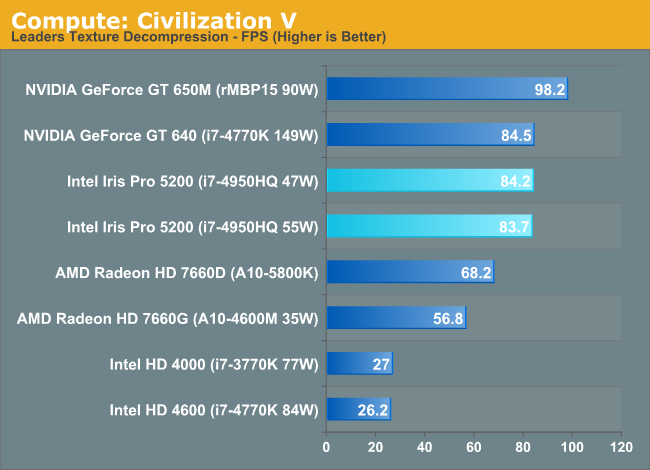
Iris Pro does very well here, tying the GT 640 but losing to the 650M. The latter holds a 16% performance advantage, which I can only assume has to do with memory bandwidth given near identical core/clock configurations between the 650M and GT 640. Crystalwell is clearly doing something though because Intel's HD 4600 is less than 1/3 the performance of Iris Pro 5200 despite having half the execution resources.
Our next benchmark is LuxMark2.0, the official benchmark of SmallLuxGPU 2.0. SmallLuxGPU is an OpenCL accelerated ray tracer that is part of the larger LuxRender suite. Ray tracing has become a stronghold for GPUs in recent years as ray tracing maps well to GPU pipelines, allowing artists to render scenes much more quickly than with CPUs alone.
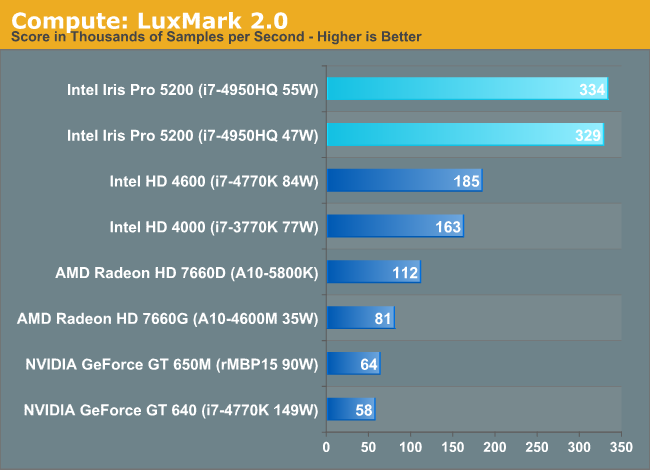
Moving to OpenCL, we see huge gains from Intel. Kepler wasn't NVIDIA's best compute part, but Iris Pro really puts everything else to shame here. We see near perfect scaling from Haswell GT2 to GT3. Crystalwell doesn't appear to be doing much here, it's all in the additional ALUs.
Our 3rd benchmark set comes from CLBenchmark 1.1. CLBenchmark contains a number of subtests; we’re focusing on the most practical of them, the computer vision test and the fluid simulation test. The former being a useful proxy for computer imaging tasks where systems are required to parse images and identify features (e.g. humans), while fluid simulations are common in professional graphics work and games alike.
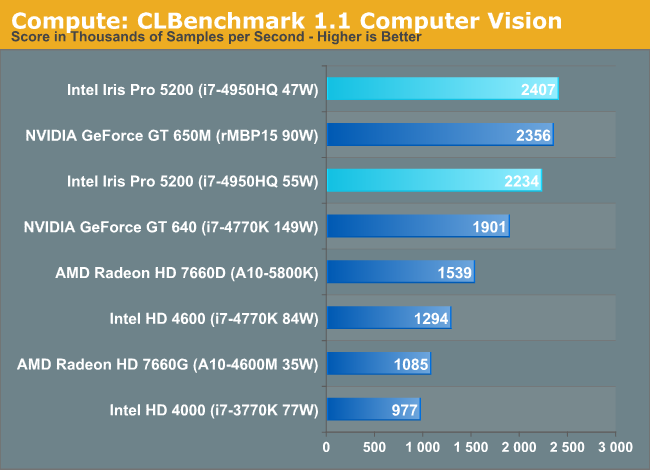
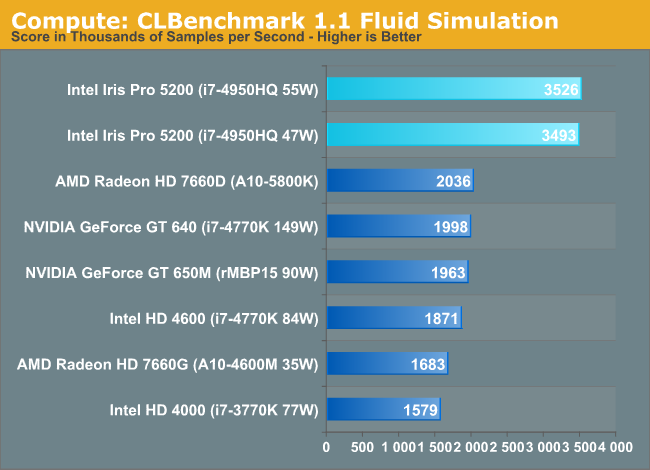
Once again, Iris Pro does a great job here, outpacing everything else by roughly 70% in the Fluid Simulation test.
Our final compute benchmark is Sony Vegas Pro 12, an OpenGL and OpenCL video editing and authoring package. Vegas can use GPUs in a few different ways, the primary uses being to accelerate the video effects and compositing process itself, and in the video encoding step. With video encoding being increasingly offloaded to dedicated DSPs these days we’re focusing on the editing and compositing process, rendering to a low CPU overhead format (XDCAM EX). This specific test comes from Sony, and measures how long it takes to render a video.
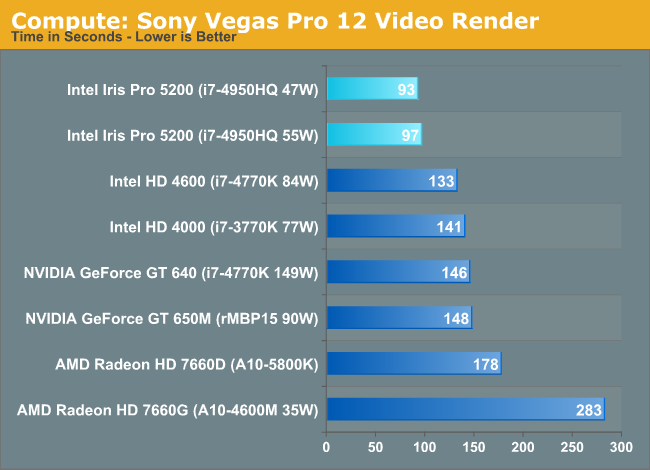
Iris Pro rounds out our compute comparison with another win. In fact, all of the Intel GPU solutions do a good job here.










177 Comments
View All Comments
tipoo - Saturday, June 1, 2013 - link
I really hope so, the Retina Macbook Pro 13" would get a whole lot more appealing with quad core and Iris Pro.DanNeely - Saturday, June 1, 2013 - link
Probably; easily if anand is right about Apple deciding it's good enough to drop the dGPU. Worst case would be Apple taking advantage of the adjustable TDP options to tune the CPU performance/tdp down a bit.Gaugamela - Saturday, June 1, 2013 - link
Really impressive!This focus of Intel on graphics will force Nvidia and AMD to push dedicated GPUs forward at a much faster pace at the risk of being destroyed by Intel iGPUs. This couldn't come at a better time with the advent of high resolution screens in notebooks and displays (that new 4K Asus monitor).
AMD will need to bring Kaveri with a monster of a iGPU otherwise Intel just nullified the only area where they had any type of advantage.
Blibbax - Saturday, June 1, 2013 - link
I question how much more can be had from APU graphics with the bandwidth restrictions of 64-bit DDR3.silverblue - Saturday, June 1, 2013 - link
Iris Pro is exceptionally good, however you have to ask how much faster the 7660D would be with the same memory bandwidth advantage. Additionally, Trinity is hardly going to be in the same sort of systems, and as the GPU is being held back by the CPU part anyway, it does take a little shine off Iris Pro's astounding performance. Even so, well done Intel, on both the hardware and software fronts.trulyuncouth1 - Saturday, June 1, 2013 - link
I think its kind of a moot point, Selling something this expensive will not affect AMD or even Nvidia that much. You can get an entire AMD APU based notebook for the cost of just this processor. I love the idea of this being pushed forward but unless Intel can bring it to a lower price point its kind of pointless.ilkhan - Saturday, June 1, 2013 - link
Im probably unique in that I want a quad haswell with the 20EU graphics and a GTX760m dGPU from a latitude (dock!) E6540. Wonder if thats going to happen. Probably not.Still, this looks damn good for Intel and will only improve over time.
lmcd - Sunday, June 2, 2013 - link
Howabout, rather, a 760 dGPU from a latitude dock? A bit more appealing :-)Zandros - Saturday, June 1, 2013 - link
Performance roughly in line with expectations, although the compute performance is a nice surprise. It seems to me like Crystalwell is going into exactly the wrong SKUs and the pricing is borderline atrocious, too.Anyway, since you bring up the awards and a "new system" for them, something I've been thinking a bit about is how there doesn't seem to be a page on the site where it is explained what each award is supposed to mean and collects all the products that have received them, which I think would be nice.
kallogan - Saturday, June 1, 2013 - link
Where is da power consumption ??????